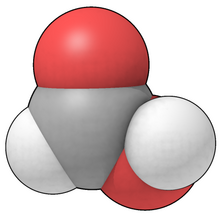Dome model



The dome model - like the rod model and the ribbon model - is one of the three-dimensional molecular models that are used to illustrate the structure of molecules in three dimensions .
description
The dome model developed in 1934 by the Swiss physicist Herbert Arthur Stuart is a further development of the rod model , with which the structure of molecules can be represented in three dimensions. The atoms of the individual elements are represented by spherical cutouts of different colors ( spherical caps ). The relationships between the atomic sizes, bond angles and bond lengths correspond to the actual relationships. The former are determined by the van der Waals radii of the individual atoms. The result is a clear and (depending on the kit and version) movable model of the molecule. The dome models are manufactured and sold by the Leybold company to this day.
In 1937, in the USA, J. Hirschfelder developed a lower-priced dome model than the one marketed by Fisher Scientific. In the early 1950s, L. Pauling and RB Corey developed their own dome model, which W. Koltun improved and which became known as the CPK model .
The representation of molecules as a space-filling model is also supported by many 3D structural programs.
Coloring
The atoms are colored according to the CPK model.
| atom | colour |
|---|---|
| hydrogen | White |
| carbon | black or gray |
| nitrogen | blue |
| oxygen | red |
| phosphorus | orange |
| sulfur | yellow |
| chlorine | green |
swell
- ↑ Herbert Arthur Stuart (1934): About new molecular models. In: Journal for Physical Chemistry (B). Vol. 27, pp. 350-358.
- ^ Robert B. Corey & Linus Pauling (1953): Molecular Models of Amino Acids, Peptides, and Proteins. In: Review of Scientific Instruments. Vol. 24, No. 8, pp. 621-627. PDF
- ^ Walter L. Koltun (1965): Precision space-filling atomic models. In: Biopolymers. Vol. 3, No. 6, pp. 665-679. PMID 4158989 doi : 10.1002 / bip.360030606
literature
- Egbert Keller: Kalottenmodelle In: Chemistry in our time, 14th year 1980, No. 2, pp. 56-60, ISSN 0009-2851
- Eric Francoeur (1997): The Forgotten Tool: The Design and Use of Molecular Models. In: Social Studies of Science. Vol. 27, No. 1, pp. 7-40. doi : 10.1177 / 030631297027001002
Web links
- Explore Whipple Collections: Space-filling models
- More about molecular models and a few examples from chemistry and biology
- History of Visualization of Biological Macromolecules - On-line Museum: 1966 Molecular Model Catalog